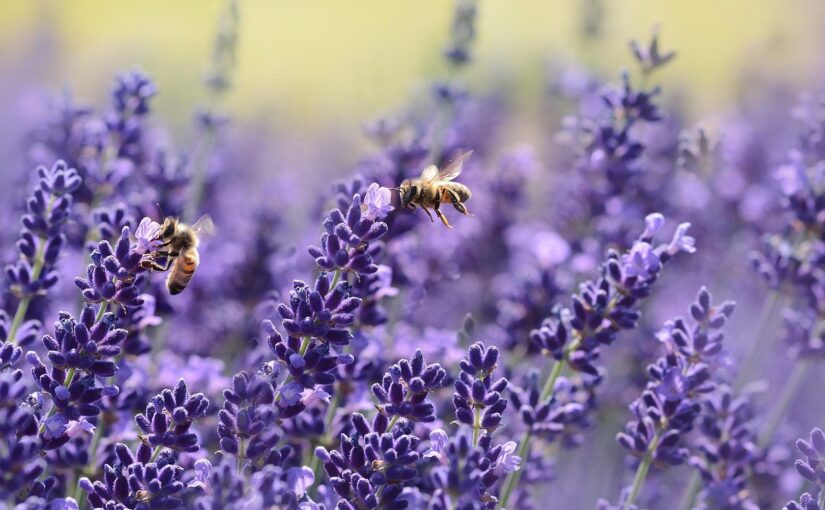“Hot lavender, mints, savory, marjoram. The marigold, that goes to bed with the sun and him rise weeping.”—William Shakespeare, The Winter’s Tale
Lavender essential oil comes from Lavandula angustifolia, a plant in the Lamiaceae family native to the Mediterranean region, including France, Spain, and Italy. It is now grown worldwide in areas like Bulgaria, England, Australia, and the United States, with major production in France, Bulgaria, and Spain. The oil is steam-distilled from the flowering tops, resulting in a pale yellow to colorless mobile liquid. Its aroma is floral, herbaceous, sweet, and slightly woody, serving as a middle note in blends. Key constituents include linalool at 20 to 45 percent, linalyl acetate at 25 to 46 percent, along with lavandulyl acetate, trace camphor, 1,8-cineole, and terpinen-4-ol. These compounds contribute to its gentle, versatile nature in wellness applications.
Historical and Cultural Significance
Lavender has a history stretching over 2,500 years. Ancient Egyptians used it in mummification and perfumery for its purifying qualities. Romans valued it for bathing and cleansing, deriving its name from the Latin word lavare, meaning to wash. In medieval Europe, monasteries relied on lavender for healing and spiritual practices, associating it with peace and restoration. Known as the Oil of Tranquility, its scent evokes the calm of sun-drenched fields. This legacy persists in modern aromatherapy, where lavender remains a symbol of serenity and care, bridging ancient rituals with contemporary self-care.
Therapeutic Benefits
Lavender essential oil offers a range of gentle yet effective benefits. As an antiseptic and antibacterial agent, it treats wounds, burns, acne, and skin infections while disinfecting minor cuts. Its anti-inflammatory properties soothe skin irritations, sunburns, and insect bites, reducing redness and discomfort. The oil acts as an analgesic, relieving headaches, migraines, muscle aches, and joint pain with targeted application. Sedative and relaxant effects promote sleep, combat insomnia, and ease anxiety or stress, helping users unwind after demanding days. Antispasmodic qualities calm muscle spasms, cramps, and respiratory issues such as asthma or bronchitis. It functions as an antidepressant, lifting mood and supporting emotional balance against mild depression. Cicatrisant actions aid scar reduction and skin regeneration, making it suitable for burns or stretch marks. Hypotensive benefits lower blood pressure and encourage cardiovascular relaxation, while immunostimulant properties strengthen immunity against colds and flu. High levels of linalool and linalyl acetate drive these calming, anti-inflammatory, and antimicrobial effects, positioning lavender as a staple for relaxation and skin health.
Aromatherapy Uses
Lavender essential oil integrates easily into daily routines. For diffusion, add four to six drops to a diffuser with 100 milliliters of water to foster relaxation or improve sleep quality. Blending it with chamomile enhances deeper calm in living spaces. Topical application involves diluting 10 to 20 drops in one ounce of carrier oil, such as sweet almond, for massage to release muscle tension or apply to temples for headache relief. It also soothes burns and irritations when used in balms at a maximum five percent dilution. Inhalation works by rubbing two to three drops in the palms and breathing deeply to reduce anxiety, stress, or headaches quickly. For baths, mix six to eight drops with a dispersant in warm water to relieve stress, relax muscles, or prepare for better sleep. Compresses can incorporate five drops in warm or cool water, soaked into a cloth and applied to bruises, sprains, or sunburns for cooling relief. It is generally safe for most skin types, but dilute to five percent, or 45 drops per ounce of carrier oil, for sensitive areas. Store in an amber glass bottle in a cool, dark place to maintain potency, with a shelf life of two to three years.
Emotional and Energetic Effects
Lavender earns its title as the Oil of Tranquility through its serene aroma, which nurtures emotional healing. It dissolves tension, fear, and overthinking, creating space for inner peace and releasing emotional blockages. The scent promotes restful sleep and a grounded sense of calm, ideal for meditation or quieting an overactive mind. Linked to the crown and heart chakras, its yin energy and air element bring balance and clarity, much like a gentle breeze across a Provençal field. It addresses anxiety, stress, insomnia, fear, irritability, and emotional exhaustion, helping individuals restore harmony in turbulent times.
Blending and Companion Oils
Lavender essential oil blends seamlessly with many aromatics to amplify its effects. It pairs well with bergamot, chamomile, clary sage, eucalyptus, frankincense, geranium, jasmine, lemon, marjoram, neroli, patchouli, peppermint, rosemary, sandalwood, sweet orange, tea tree, vetiver, and ylang-ylang. Companion oils like chamomile, clary sage, ylang-ylang, sandalwood, and vetiver enhance its calming floral profile. For similar soothing results, substitutes include lavandin, clary sage, or bergamot, each offering floral notes with relaxing benefits.
Safety and Precautions
Lavender essential oil is well-tolerated, but precautions ensure safe use. Skin sensitization is rare, yet patch testing is advised for sensitive skin or allergies, and oxidized oil should be avoided. It is safe in low dilutions of one to two percent for children over two and pregnant women after the first trimester, though professional consultation is recommended. Store in an amber glass bottle in a cool, dark place and discard after two to three years if the aroma shifts. Authenticity matters, as lavender oil is sometimes adulterated with synthetic linalool or cheaper lavandin. It is intended for external use only and should not be ingested without professional guidance.
Lavender’s Calming Whisper
Lavender essential oil captures the essence of sunlit fields in Provence, its floral, herbaceous scent melting away worries and cradling users in peace. A timeless healer from ancient rituals, it soothes skin, eases aches, and quiets the mind with gentle care. Whether diffused for serenity or applied for healing, lavender invites deep rest, rooted in the enduring calm of Mediterranean traditions.
Image by Rebekka D.
If your heart finds joy and inspiration here, consider supporting the work that keeps these stories blooming. Your donation, no matter the size, helps sustain authentic research, creative writing, and the spirit of sharing that connects us all.
